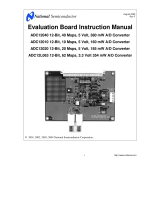
www.ti.com
Bill of Materials, Layout, and Schematic
15
SBAU193C–July 2011–Revised February 2016
Submit Documentation Feedback
Copyright © 2011–2016, Texas Instruments Incorporated
ADS8568EVM-PDK
Table 7. Bill of Materials
Item Quantity Designator Description Manufacturer Part Number
1 1 N/A Printed wiring board TI 6521094
2 8 C1, C18, C19, C25-C27, C63, C66
Capacitor, ceramic, 39 pF, 50 V, 5%, C0G,
0603
Murata GRM1885C1H390JA01D
3 25
C2, C3, C11, C15, C22, C24, C32-C36, C38-
C41, C46-C48, C50-C52, C59, C81, C84, C86
Capacitor, ceramic, 0.1 µF, X7R, 50 V, 10%,
0603
Murata GRM188R71H104KA93D
4 0 C4, C7, C8, C10, C17, C20, C64, C67 Not installed — —
5 13
C5, C6, C9, C12, C14, C42-C45, C53, C57,
C58, C61
Capacitor, ceramic, 10 µF, X5R, 16 V, 20%,
0805
TDK C2012X5R1C106M
6 8 C13, C16, C28-C31, C62, C65
Capacitor, ceramic, 2200 pF, 50 V, 5%, C0G,
0603
Murata GRM1885C1H222JA01D
7 5 C21, C23, C49, C54, C85
Capacitor, ceramic, 1 µF, X5R, 35 V, 10%,
0603
Taiyo Yuden GMK107BJ105KA-T
8 1 C37
Capacitor, ceramic, 0.47 µF, X5R, 10 V, 10%,
0603
Murata GRM188R61A474KA61D
9 2 C55, C60
Capacitor, ceramic, 22 µF, X5R, 6.3 V, 10%,
0805
Taiyo Yuden JMK212BJ226KG-T
10 1 C68, C69 Capacitor, ceramic, 4.7 µF, 25 V, X5R, 0805 Murata GRM21BR61E475KA12L
11 2 C70, C72
Capacitor, ceramic, 0.01 µF, X7R, 50 V, 10%,
0603
Murata GRM188R71H103KA01D
12 2 C71, C83 Capacitor, ceramic, 150 pF, 50 V, C0G, 0603 TDK C1608C0G1H151J
13 8 C73-C80
Capacitor, ceramic, 4.7 µF, 25 V, X7R, 10%,
1206
TDK C3216X7R1E475K
14 1 C82
Capacitor, ceramic, 0.22 µF, 16 V, X7R, 10%,
0603
TDK C1608X7R1C224K
15 2 D1, D2 LED, 565nm, green diff, 0603, SMD Lumex SML-LX0603GW-TR
16 2 D3, D4 MBRM120, Schottky, 1 A, 20 V, PowerMite On Semi MBRM120ET3G
17 5 FB1-FB5 Ferrite chip, 600 Ω, 500 mA, 0805 TDK MMZ2012R601A
18 1 J1 Connector, SMA, jack, straight PCB Amphenol 132134
19 1 J1 Connector, SMA, jack, straight PCB Emerson 142-0701-201
20 2 J2, J4 (Top) 10-pin, dual row, SM header (20 posible) Samtec TSM-110-01-T-DV-P
21 2 J2, J4 (Bottom) 10-pin, dual row, SM header (20 posible) Samtec SSW-110-22-F-D-VS-K
22 1 J3 (Top) 5-pin, dual row, SM header (10 posible) Samtec TSM-105-01-T-DV-P
23 1 J3 (Bottom) 5-pin, dual row, SM header (10 posible) Samtec SSW-105-22-F-D-VS-K
24 1 J5 (Top) 16-pin, dual row, SM header (32 posible) Samtec TSM-116-01-T-DV-P
25 1 J5 (Bottom) 16-pin, dual row, SM header (32 posible) Samtec SSW-116-22-F-D-VS-K
26 15
JP1, JP2, JP4-JP8, JP10, JP11, JP13, JP14,
JP18-JP20, JP23
3-pin, 2-mm header Samtec TMM-103-01-T-S
27 1 JP3 3-pin, dual row, header (6 posible) Samtec TSW-103-07-T-D
28 1 JP9 4-pin, triple row, header (12 posible) Samtec TSW-104-07-T-T
29 6 JP12, JP15-JP17, JP21, JP22 2-pin, 0.1-inch header Samtec TSW-102-07-T-S
30 2 L1, L2 Power inductors, 5.3 µH, 1.90 A Sumida CDRH5D28NP-5R3NC





















